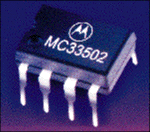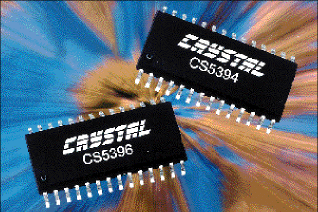1997 Editors' Roundup:
Mixed-signal ICs and CAE tools
This past year's flood of linear ICs sent no mixed signals about the
demand for analog-circuit functions. Among building-block functions, the
MC33502 dual op amp (see Electronic Products , June 1997, p. 86)
from Motorola Semiconductor (Phoenix, AZ) illustrates the trend toward
lower supply voltages.

Motorola Semiconductor MC33502
The device operates from single supplies as low as 0.9 V over a –10°
to 105°C temperature range. Operating from 1 V, the rail-to-rail IC
delivers up to 10 mA and has a unity-gain bandwidth of 4 MHz.
From Analog Devices (Norwood, MA), the AD8009 current-feedback op amp
(see Electronic Products , May 1997, p. 114) offers high-speed operation.
It has a slew rate of 5,500 V/µs and rise and fall times of 725 ps
for a 4-V step. The device's 3-dB bandwidth at unity gain is 1 GHz and
SFDR measures 53 dBc at 70 MHz.
Among data converters, the CS-5396 24-bit A/D converter (see Electronic
Products , Nov. 1997, p. 124) from Cirrus Logic (Austin, TX) stood out
for its 120-dB dynamic range and 96-kHz sampling capability.

Cirrus Logic CS5394/96TT
Intended for stereo digital audio systems, the device performs sampling,
A/D conversion, and anti-alias filtering to generate 24-bit serial output
for left- and right-channel inputs.
In the area of data storage, Silicon Systems' (Tustin, CA) family of
Enhanced Partial Response Type 4 (EPR4) read-channel devices (32P-4101/03/05)
(see Electronic Products , Aug. 1997, p. 72) offers disk-drive designers
faster performance and better signal to noise ratio (SNR). The read channels
deliver over a 2.0-dB improvement in SNR (over PR4) at a user density of
2.5.

Silicon Systems 32P4101/03/05 EPR4
In power conversion, switching regulators continued to push the limits
of integration. From Power Integrations (Sunnyvale, CA), the TOPSwitch-II
PWM switches (see Electronic Products , April 1997, p. 58) operate
off-line to generate 0.5 to 150 W of dc power. Offered in 3-pin TO-220s,
the TOP221 to 227–which combine control and power circuits–implement
a highly integrated switching power supply that is cost competitive with
linear supplies at outputs as low as 5 W.
Battery charging made similar strides with introductions like Philips
Semiconductors' (Sunnyvale, CA) TEA1102, a one-chip fast-charge controller
for all common battery types (see Electronic Products , Jan. 1997,
p. 90). The charger provides several methods of charge detection, including
/T//t and peak voltage for NiCd and NiMH batteries, and preset voltages
for sealed-lead-acid and Li-ion batteries.
Motor applications also benefitted from more versatile control circuits.
From TelCom Semiconductor (Mountain View, CA), the TC642 PWM fan speed
controller (see Electronic Products , Dec. 1997, p. 70) is a standalone
part that controls and monitors brushless dc fans of any current or voltage
based on input from a temperature sensor. The device integrates fan fault
detection with speed control.
The ML4423 from Micro Linear (San Jose, CA) generates the PWM sine-wave
signals needed to control three-phase ac induction motors (see Electronic
Products , May 1997, p. 111). The IC replaces multichip designs built
around digital signal processors or microcontrollers and mechanical solutions
constructed with transmissions and pulleys.
Many of the RF components announced in the past year recognize the need
for no-fuss wireless designs. For example, the LC series of RF modules
(see Electronic Products , July 1997, p. 107) from Linx Technologies
(Medford, OR) implement a 2.5-kbit/s wireless data link at distances in
excess of 250 feet. These transmitters and receivers, which require no
external components except for an antenna, provide unlicensed operation
at 318, 418, and 433.92 MHz. The transmitters are offered in 9 x 12-mm
SMT packages, while the receivers are offered in 14 x 20-mm SMT packages.
At the chip level, applications like cellular are driving the tighter
integration of many RF functions. For example, Triquint Semiconductor (Beaverton,
OR) has introduced a 0.6-µm GaAs MESFET process that permits integration
of transmit and receive circuitry on the same chip (see Electronic Products ,
May 1997, p. 17). Called TQTRx, the process supports mixed-signal designs
with LSI complexity and operation up to the Ku-band.
In the area of design automation software, Omniview Galaxy, from Omniview
(San Mateo, CA), sought improved productivity through design reuse (see
Electronic Products , June 1997, p. 99). A design environment for
board- and system-level digital designs, Omniview Galaxy allows designers
to synthesize designs from high-level descriptions while accounting for
critical design parameters such as power and cost. The tool, which interfaces
to popular EDA environments, automates component selection, timing analysis,
and schematic generation.
–David Morrison
Advertisement





